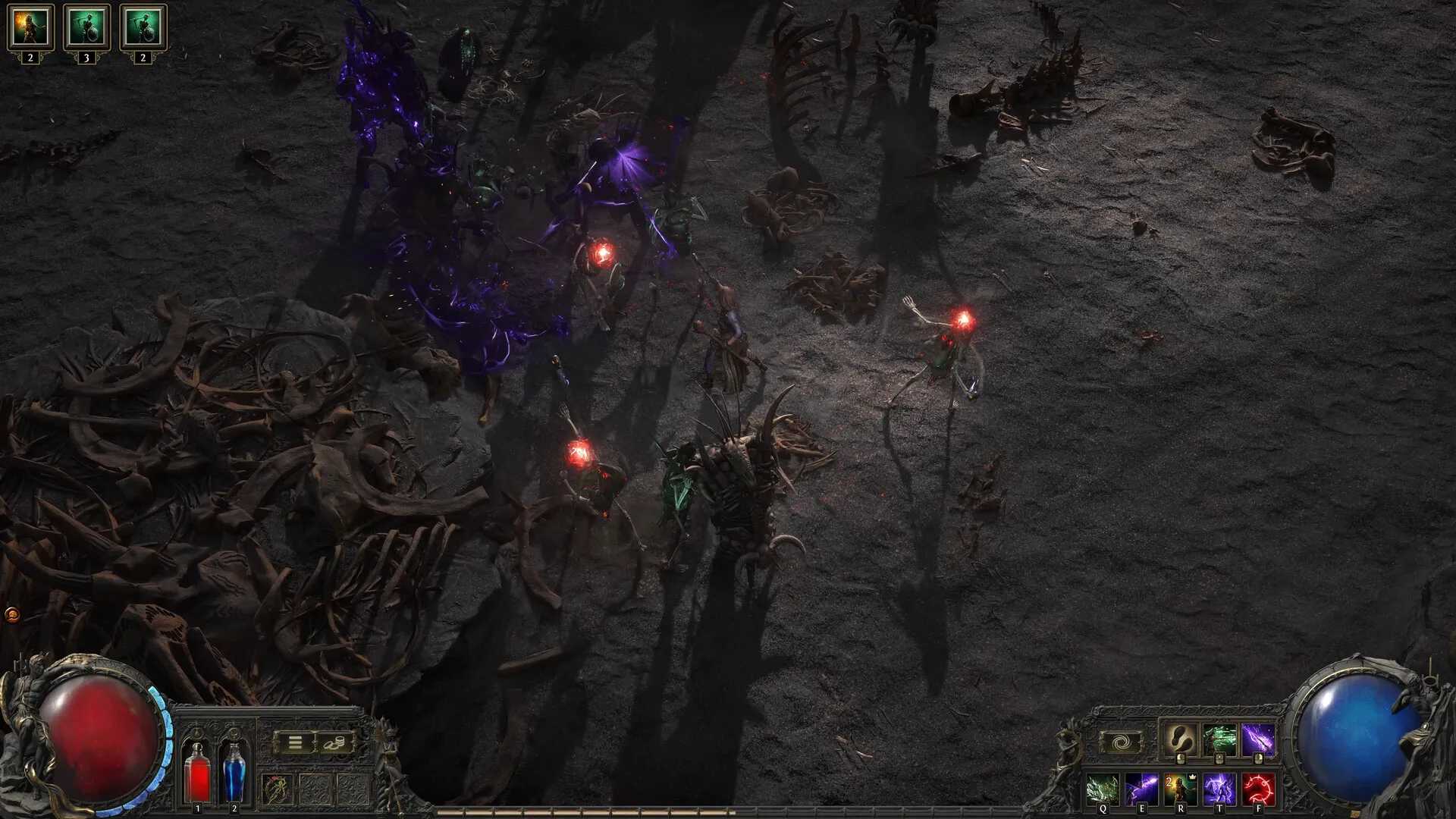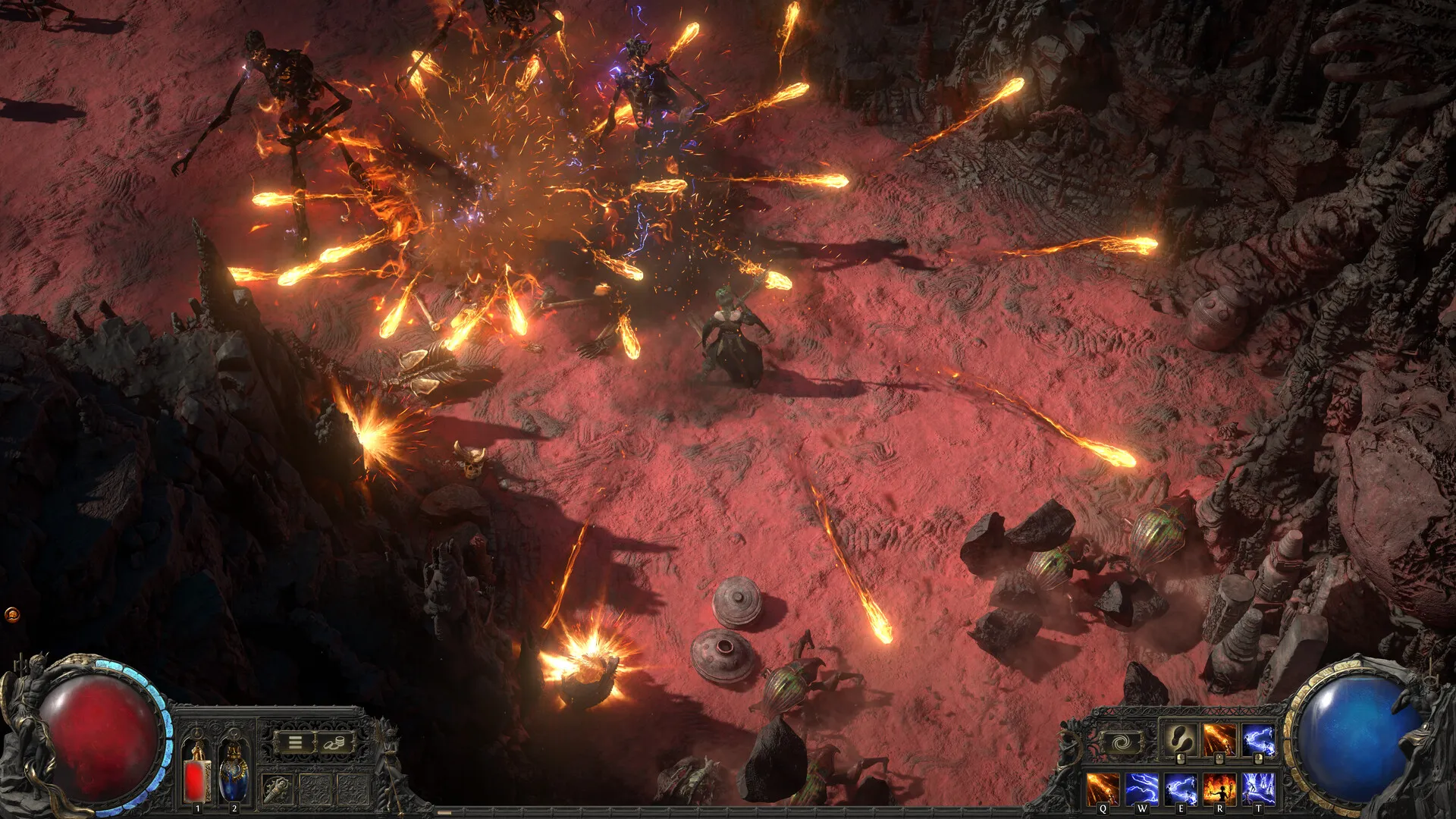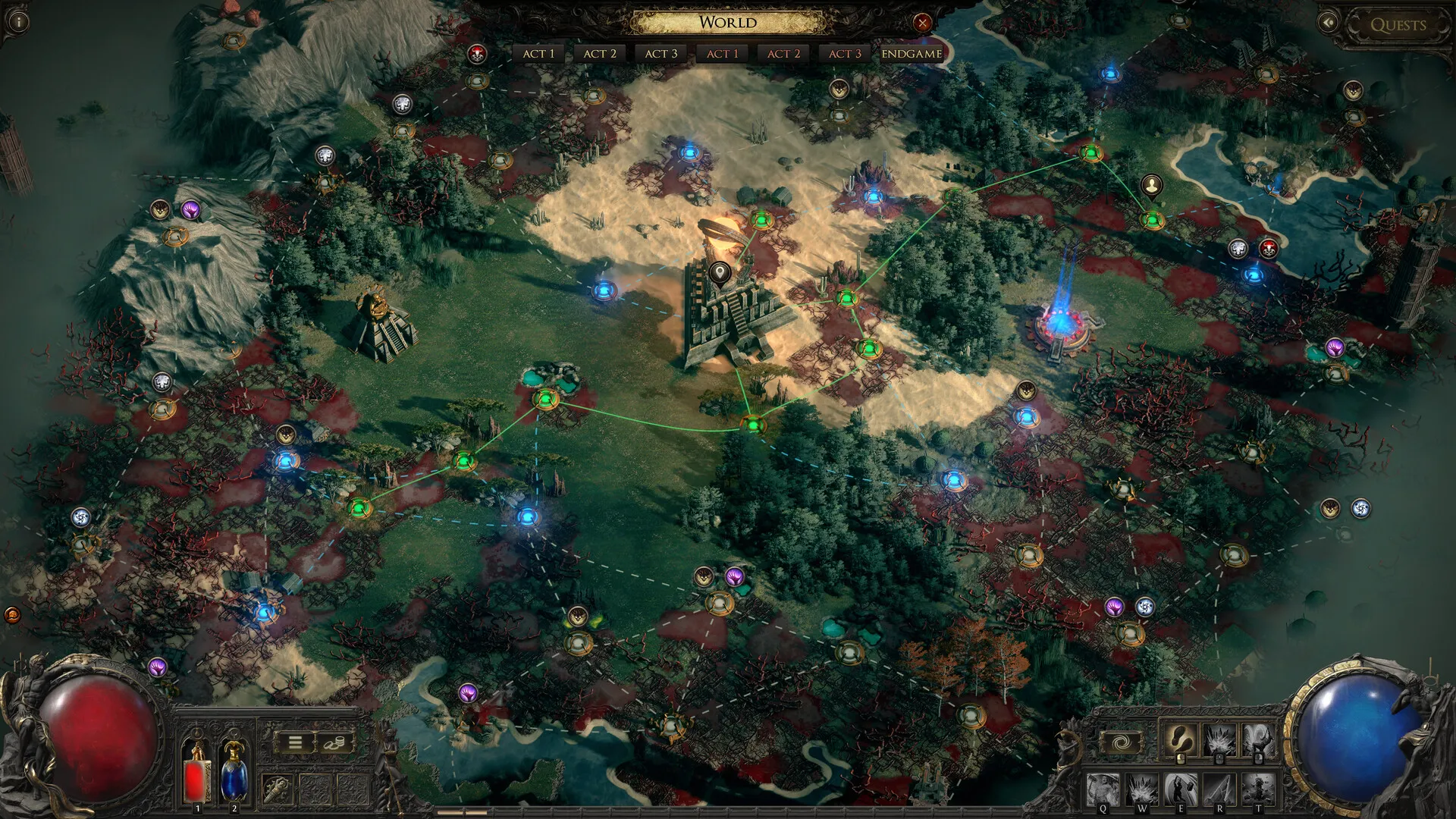The combat system in Path of Exile 2 demands a level of thought that is common in games like Souls. This sequel supports a more strategic approach than many other ARPGs that let players crush enemies with sheer strength. Players must stay alert in each battle and think about enemy patterns and potential dangers.
Because of how hard the game is, even known enemies can be very dangerous if you don’t pay attention. A rewarding cycle of learning and mastery starts with this increased sense of challenge. Each win feels hard-won and important.
Path of Exile 2’s combat mechanics are perfectly complemented by its open-world concept. Improvements to movement, like dodge-rolling and the addition of WASD navigation, provide fluidity that enhances player agency. Exploration is very rewarding, and there are huge places to explore, each filled with hidden treasures and dangers. The game’s design ensures that players are frequently involved in combat, finding a balance between discovery and conflict.
However, this freedom is not without risk. Players are encouraged to get lost in Wraeclast’s lore and scenery while being constantly aware of the dangers lurking around every corner because the world feels alive. This duality enriches the narrative experience because players’ choices in combat and exploration directly impact their choices and how the story goes.
Character Customization: Crafting Your Hero
Path of Exile 2 lets players choose from six different types of characters: the Sorceress, the Warrior, the Ranger, the Witch, the Mercenary, and the Monk. Each class is designed with distinctive playstyles that cater to various player preferences, offering a solid base for character growth. For example, the Sorceress is great at elemental magic, which makes for a fluid and exciting gameplay experience.
On the other hand, the Warrior is all about raw strength, charging into battle with heavy armor and deadly close-range attacks. The diversity of classes not only enriches gameplay but also encourages players to experiment with different strategies and tactics. The potential for customization increases as Grinding Gear Games intends to add twelve more classes, promising even more character variety and playstyle diversity.
In Path of Exile 2, the passive skill tree is the most important part of customizing your character. This is something that the series is known for. This huge network of powers, which has more than 1,500 perks, lets players make their characters feel very unique. Players can mix and match support and skill gems, creating custom builds tailored to their play style. For example, a player might choose to enhance a Sorceress’ Frostbolt to increase its damage and change its mechanics with support gems like Scattershot, allowing for multiple projectiles.
When you’re new to the series, this level of complexity can be scary, but it makes you care more about each character. Players are crafting a narrative that reflects their journey through Wraeclast in addition to choosing skills. The freedom to experiment with different build paths increases replayability and reinforces the theme of player choice and consequence.
Path of Exile 2 encourages creative experimentation, making each playthrough an opportunity for individual storytelling, unlike more linear RPGs, where character development is often predetermined. Players are encouraged to explore the game’s world further thanks to the delicate mix of mechanics and narrative that makes each choice feel important.
Combat System: A Symphony of Strategy and Skill
With a focus on skillful execution and tactical decision-making, Path of Exile 2 brings back the action-packed gameplay of its predecessor. This sequel demands that players connect with its systems on a deeper level, in contrast to many traditional ARPGs that reward mindless button mashing. As players must adapt their strategies in real-time, combat encounters necessitate a keen understanding of enemy behaviors.
This is especially important during boss fights, where mastering mechanics and attack patterns is essential. Each enemy is different, and it often takes more than one try to learn their tricks. This cycle of trying and failing creates an emotional sense of success that echoes the thrill of overcoming tough times.
In Path of Exile 2, the boss fights are especially well thought out, offering various challenges that keep players on their toes. Not only does each boss look different, but it also has a different set of mechanics and demands different strategies to beat. The game makes good use of audio cues to enhance the experience. For example, many bosses dramatically announce their attacks, allowing players to prepare for them and respond appropriately. The dramatic flair of these times adds to the overall atmosphere, increasing player involvement and enriching the narrative experience.
Each encounter’s emotional stakes are raised by the integration of these mechanics into the narrative structure. Players aren’t just fighting for items; they’re also interacting with the world of Wraeclast. The tension of each fight reflects the game’s main themes of struggle and persistence. The combat system is elevated above simple gameplay by this fusion of mechanics and storytelling, creating a gripping narrative in which each fight has a purpose. Players will feel a strong connection to their characters and the world they live in due to the difficult and rewarding combat experience created.
Visuals and Atmosphere: A Darkly Immersive World
stunning compared to its predecessor, taking the series’ look to a whole new level. The graphics not only make the game more detailed, but they also give it a sense of realism, which enhances the whole experience. The character models, scene textures, and sound effects are all rendered with a high level of detail that pulls players into the dark world of Wraeclast.
Dark settings, creepy creatures, and haunting lighting all work together to give the game a sense of foreboding, which this visual upgrade supports. The art direction reflects the narrative’s somber tone, further emphasizing the sense that players are navigating a dangerous and hopeless world.
How the environments are designed in Path of Exile, 2 makes the experience even more realistic. Each area was carefully designed to have a mix of atmospheric elements that make you want to explore while keeping a real sense of tension. Many secret spots in the huge landscapes make players want to go off the beaten path. As players experience lore-rich environments that tell their own stories, this design choice enriches the gameplay and deepens the narrative.
The interaction between the visuals and the gameplay mechanics is also interesting. The vivid graphics increase the emotional effect of battles, making each victory more rewarding and each battle more intense. The environments react to the players’ choices, creating an immediate and profound sense of consequence. In this way, the visuals become integral to the game, luring players to lose themselves in a beautiful and brutal world.
Narrative Structure: Weaving Tales of Darkness
With a narrative that develops through character interactions and environmental lore, Path of Exile 2’s campaign structure is a captivating combination of immersive lore and rich storytelling. It draws players into its dark world. The campaign is designed around a series of acts, each of which is filled with quests that show Wraeclast’s dark past.
The narrative here enables players to interact closely with the world through conversation with NPCs, deepening their understanding of the lore, in contrast to the linear storytelling in many RPGs. Characters aren’t just there to give you quests; they’re integral to the experience and often have personal stakes in what happens, which enhances your emotional investment.
To reach the end game content, players must replay the first three acts on a harder setting called Cruel mode. While possibly tedious, this design choice can also increase player engagement by allowing for the second playthrough to focus on mastery of mechanics and narrative elements.
However, this necessity may also slow things down since the campaign’s repetitive nature can feel long after the original thrill wears off. While some players may relish the opportunity to refine their narrative and strategies, others may find that the repetition detracts from overall enjoyment. The challenge lies in balancing the narrative’s depth with the potential for monotony.
In the end, Path of Exile 2’s narrative structure encourages and tests players’ patience, creating a dynamic that reflects the game’s themes of fortitude in the face of darkness.
Endgame Content: The Depths of Wraeclast Await
The end campaign of Path of Exile 2 is where the game grows, offering a ton of content designed to keep players interested long after the campaign. The Atlas is the main part of this experience. It’s a huge area that uses procedural generation to ensure that each playthrough differs.
This system lets players explore different nodes, and each one leads to a different set of enemies, bosses that are hidden, and mysterious traders. The procedural nature of the Atlas not only enhances replayability but also encourages players to experiment with various character builds and strategies, as each journey through its depths can bring new surprises and challenges.
Aside from the Atlas, players can do many different things, such as trials that test their skills under certain situations and modifiers. In order to help players learn more about the game’s mechanics, these trials are designed to force them to adapt and refine their strategies. The endgame’s boss fights are especially interesting because each has unique mechanics requiring skill and planning. Diversity in the challenges is essential for the gameplay experience to remain fresh and exciting.
The endgame content in Path of Exile 2 is deep and varied, offering players various challenges that cater to casual and experienced gamers. Players can face trials, explore the Atlas, or face off against formidable bosses, each offering rewards and challenges. Because these challenges are so hard, players can spend much time perfecting their builds and strategies.
Additionally, the game promotes experimentation and player choice, allowing for significant customization and individual expression in character development. Because of this freedom, players can frequently pursue new objectives, such as improving their trial scores or learning the mechanics of a particularly challenging boss. The option for multiple potential paths lengthens the game and reinforces the themes of choice and consequence that run throughout it.
Path of Exile 2’s end game is a web of complicated systems that award exploration, skill, and creativity, making it a compelling draw for players who want to learn more about the eerie world of Wraeclast.
Early Access Considerations: Navigating the Growing Pains
Path of Exile 2 has its share of technical issues that can ruin the experience, as is the case with many early-access games. Players have noted bugs affecting gameplay stability, such as small glitches. Performance drops have been a regular issue, especially in intense combat situations or when there are a lot of effects on screen.
These issues are normal for a game still being worked on, but they can be annoying and take away from the experience. At the same time, Grinding Gear Games has shown that they are committed to fixing these problems by releasing regular updates. This gives us hope that the experience will improve as the game improves.
Players have had mixed feelings about the loot system, which is an important part of any ARPG. Many players appreciate the diversity of the game and the thrill of discovery, but some have voiced worry about the frequency of loot drops and the usefulness of the items found. The excitement of looting can be lowered if players frequently find themselves surrounded by useless or unimportant gear. There are hopes for changes to the loot economy as the game moves through its early access phase, with the potential to reduce drop rates and increase the value of items.
The integration of player feedback is essential to making the loot system one that rewards research and hard work. As players look for gear that successfully complements their chosen builds and enhances their journey through Wraeclast, balancing these factors will improve gameplay and align with the overarching narrative themes of choice and consequence. As long as the developers keep listening to what the community says, there is still much room for improvement, promising a better looting experience.
The Review
Path of Exile 2
With a rich fusion of intricate mechanics, compelling storytelling, and stunning visuals, Path of Exile 2 builds on the success of its predecessor. The world, characters, and endgame content can all be changed in many different ways, making the game fun for new and experienced players. Even though technical issues and feedback on the loot system show that the game needs work in its early access phase, it's clear that it has a lot of potential. It should become a great game if developers keep working on it.
PROS
- Deep character customization and skill tree.
- Immersive storytelling with rich lore.
- Stunning visuals and atmospheric environments.
- Engaging endgame content with diverse challenges.
- Strong community and developer support.
CONS
- Technical issues and performance drops.
- Loot drop rates and item relevance need improvement.
- Repetitive campaign pacing during higher difficulties.





















































